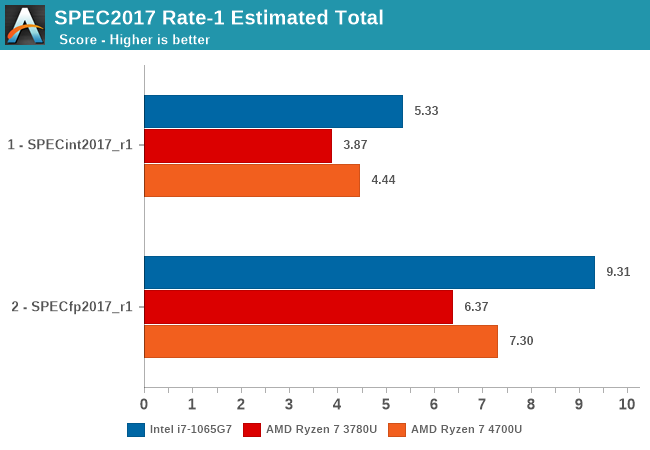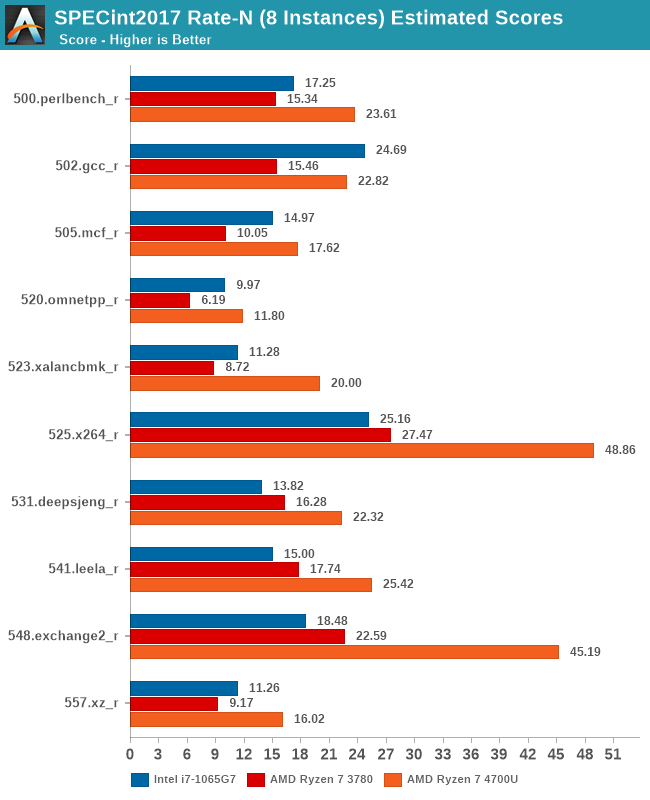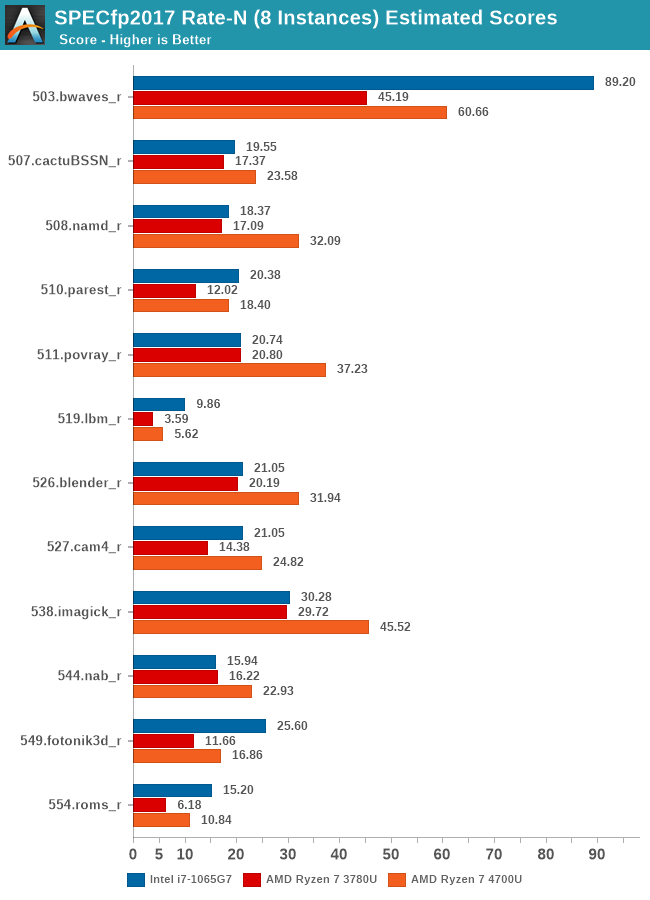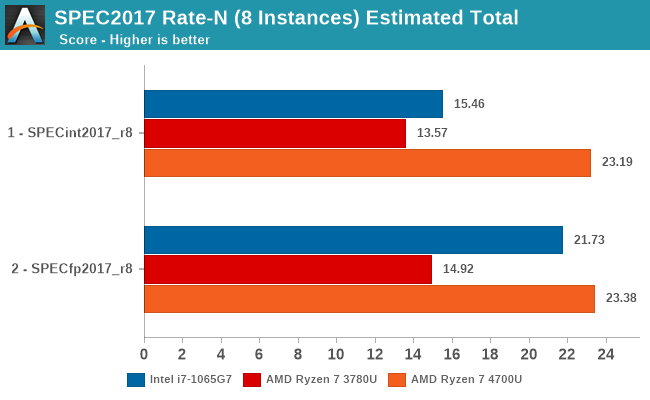The Acer Swift 3 SF314 Notebook Review: Swift Gets Swifter With Ryzen 4000
by Brett Howse & Andrei Frumusanu on May 5, 2020 8:00 AM ESTSection by Andrei Frumusanu
SPEC: Renoir vs Picasso vs Ice Lake
Kicking off our look at performance, let's start with SPEC and analyzing how AMD managed to increase the performance against Picasso with its first-generation Zen cores. The newer generation Renoir with Zen2 cores should in theory see more significant performance upgrades thanks to the improved IPC of the new microarchitecture – but today’s 4700U also is just a mid-tier part with a lower 15W TDP as well as “just” featuring DDR4-3200 – not the fullest memory configuration possible as the SoC also support LPDDR4X up to 4266 MHz.
For our SPEC harness, We’re testing under WSL1 in Windows due to simplicity of compilation and compatibility, and are compiling the suite under LLVM compilers. The choice of LLVM is related to being able to have similar code generation across architectures and platforms. Our compiler versions and settings are as follows:
clang version 8.0.0-svn350067-1~exp1+0~20181226174230.701~1.gbp6019f2 (trunk) clang version 7.0.1 (ssh://git@github.com/flang-compiler/flang-driver.git 24bd54da5c41af04838bbe7b68f830840d47fc03) -Ofast -fomit-frame-pointer -march=x86-64 -mtune=core-avx2 -mfma -mavx -mavx2
Our compiler flags are straightforward, with basic –Ofast and relevant ISA switches to allow for AVX2 instructions.
Single-Threaded Performance

In SPECint2017, the new Zen2 based Ryzen 7 4700U is performing well, although the score increase compared to the last-generation 3780U aren’t as big for some workloads. As a reminder, the 3780U clocks up to 4.0GHz in terms of boost clocks while the 4700U clocks up to 4.1GHz. SMT being disabled on the 4700U should also give it a slight advantage in IPC over other Zen2 platforms given that it doesn’t have to statically share some core resources anymore in this mode.
Renoir showcases the biggest increases in workloads such as 548.exchange2_r and 525.x264_r which are back-end execution bound workloads, and the microarchitectural improvements here help a lot.
On the other hand, the weakest improvements are seen in workloads such as 520.omnetpp_r – this test is mostly memory latency bound and unfortunately the new chip here barely just matches its predecessor. The same can be said about 505.mcf_r where the improvements are quite meager.
The generational improvements here aren’t enough to catch up to Intel’s Sunny Cove cores in the Ice Lake i7-1065G7. Although that core might be running at higher single-core TDPs and power consumption, it still makes for a big gap in some of the more instruction pressure and cache pressure high workloads such as 500.perlbench_r and 502.gcc_r where the Intel chip still has a considerable lead in.

In SPECfp2017, these are floating point heavier test workloads. The generational increases here are also relatively smaller, with even an odd regression in 527.cam4_r. The Intel chip still has a lead across the board, and with particular large gaps in the more memory heavy workloads such as 519.lbm_r and 549.fotonik3d_r.

Overall, in terms of single-threaded performance, the Zen2 Renoir chip might seem a bit underwhelming, but when looking at the IPC improvement it’s actually not that far off from what’s expected of the new microarchitecture. In both SPECint and SPECfp we see a 12% performance per clock improvement, which is generally in line with Zen2’s generational improvements. As a reminder, the mobile chips here only feature a quarter the CCX L3 cache compared to its desktop counterparts, and that will result in smaller IPC gains, especially in memory heavy workloads.
AMD’s higher-end SKUs such as the 4900HS score slightly better due to the higher boost frequencies, but nothing significant enough to change the single-threaded competitive landscape; Intel still has a substantial advantage here thanks to a much stronger memory subsystem.
Multi-Threaded Performance
The multi-threaded performance comparison today is actually quite interesting just for the fact that the 4700U doesn’t feature SMT. Whilst it lacks multi-threading on the cores, it makes up for it by simply having 8 physical cores on the chip, double that of Picasso-based SoCs as well as Intel’s latest Ice Lake CPUs. Again, performance here will be strongly impacted by the TDP as well as cooling of the systems. Both AMD parts are 15W TDP designs, while the Intel chip sustains 25W.

The resulting multi-threaded performance is quite varied across the benchmarks. What immediately stands out is that in purer execution heavy workloads the new Renoir chip pretty much demolishes its predecessor as well as the competition. This makes sense given that Zen2 has good execution resources and Renoir has double the physical core count to scale up performance.
Renoir’s performance here is very good across most workloads, but there’s a few workloads where Intel’s Ice Lake CPU comes closes or beats it even (502.gcc_r) – again these are the workloads that are most memory intensive.

SPECfp across 8 instances again shows similar results. Renoir fares extremely well across execution bound workloads, but this time around loses a lot more often against the Ice Lake chip in memory-bound workloads even though it has a 2x core count advantage.
The chip’s performance in memory-bandwidth heavy 519.lbm_r is particularly odd as it manages to fare worse than single-core results of a desktop Zen2 based system, and again far behind the Ice Lake counterparts.

Overall, AMD’s 4700U’s multi-threaded performance is fantastic in areas where it should matter most in a laptop-based system. The 2x core count advantage more than makes up for the lack of SMT, and workloads such as rendering and other creative tasks are the platform’s strong-points. In more memory-heavy workloads, performance doesn’t scale all that well as clearly the new chip still has a big weakness in its memory subsystem – scientific workloads or code compiling won’t scale nearly as well.
We have to wonder how Renoir will fare on an LPDDR4X configured system – unfortunately we haven’t been able to test such a platform yet. Overall, the 4700U seems like an excellent chip given its 15W TDP, but let’s see how it performs in our system benchmark suite…










191 Comments
View All Comments
psychobriggsy - Tuesday, May 5, 2020 - link
Yeah, but then you're stuck with two small SODIMMs to replace when you want more memory...My 2700U HP came with 1 8GB stick, buying another stick later on when I needed to double capacity was a lot cheaper than rebuying the full desired capacity.
OTOH 16GB isn't a lot these days - and I'd prefer to get the 16GB in soldered fast LPDDR4X form with Renoir and hope I never need 32GB!
ads295 - Tuesday, May 5, 2020 - link
So I guess you'd have to plan ahead, then. I was going to upgrade to 4x2 initially but I went with 8x2 after some consideration.But would you really need more than 16 if you're a casual user? What are your workloads like? I do light gaming, web browsing and that sort and even 8 would've been enough for me.
fmcjw - Tuesday, May 5, 2020 - link
Lenovo Yoga series was the worst with their single channel atrocities, hope they come to their senses in 2020.Swift 5 2020 (only offered with Intel, no AMD configs I know of) has 8GB onboard with an empty slot running in single channel, but I'm curious how many users think to add another stick. In that case 16GB of onboard RAM is better, at least it reduces BSOD from mismatched RAM.
BTW, if you add a 16GB SO-DIMM to the 8GB onboard, do you get at least the same performance and benefits as 16GB in dual channel mode, or does it create instabilities and other system-wide complications?
csp4me - Tuesday, May 5, 2020 - link
please check your sources man, Swift 5 2020 under 1 kg can never have empty slots, everything is soldered. https://www.notebookcheck.net/Acer-Swift-5-Laptop-...fmcjw - Wednesday, May 6, 2020 - link
You're right, thanks, I got it mixed up with the LG Gram (2020). Acer is soldered.Spunjji - Wednesday, May 6, 2020 - link
Adding a 16GB SO-DIMM to a system with 8GB soldered gives you dual-channel performance for the first 16GB pool of system RAM, with the remaining 8GB running at single-channel performance.neblogai - Tuesday, May 5, 2020 - link
Regarding RAM: at least in China, Swift 3 models with 8GB come with LPDDR4 3200, but there is also a 16GB version, and that uses LPDDR4X 4266, costing ~15% more. It came a ~month later than the 8G model.eddieobscurant - Tuesday, May 5, 2020 - link
I don't understand why they don't offer a model with more ram. 8gb, non-upgradable ram is too low.Holliday75 - Tuesday, May 5, 2020 - link
For who? Most business and casual users 8gb is plenty.My company has 10's of thousands of 8gb laptops deployed and we rarely see the need for more and my users love their huge ass spreadsheets and Chrome. Most home users like my family and friends would be fine with it as their workloads are not as robust.
Me personally I would like 16gb for home use as I game. At work I am happy with my 4th gen Intel processor and 8gb of RAM.
RinzImpulse - Wednesday, May 6, 2020 - link
Umm... don't forget that system RAM will be shared with iGPU, so, most likely you'll only get 6-7 GB free for windows which I'm sure it won't be enough even for most